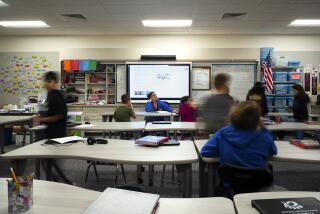Small Classes Help More Than Latest Computers
- Share via
I remember being dragged to the General Electric Carousel of Progress at Disneyland when my father tired of racing from one ride to another. There, he would settle back and dream of happier days to come via the promise of technology: rest at long last with the push of a button. The smiling automatons manning their marvelous machines promised to liberate us from the blood, sweat and toil of the past.
As a child I had no interest in these adult toys. I felt frightened when I was trapped inside that theater watching those smiling plastic people and their “smart machines.” Now, those futuristic visions a la Disney seem silly in light of what have become everyday technological realities.
However, despite living in a techno-wonder world never dreamed of in my youth, I’m not sure I’m any happier than my father was sitting inside that Carousel of Progress dreaming of a Buck Rogers universe. Composing on my already outdated computer, I feel I’m no closer to understanding the perils and passions of the human experience than my distant ancestors were while painting in the darkness of their caves.
So as an educator, I’m not sure that any piece of current technology will necessarily better equip me to teach my students what they’ll need to know tomorrow. My students are as enthusiastic about our vision of the future as I was about GE’s Carousel of Progress.
It seems to me that although adults are awed by the wonders of computers and the Internet, kids are less impressed. While I concede the importance of having well-equipped computer labs on campus and a computer work station in each classroom, I’m not sure calls to place a computer on every school desk are wise.
Often, technology merely provides a break from the grind of having to face one another day in and day out. Human interaction is exhausting. What schoolteacher wouldn’t welcome a computer in front of every student . . . finally, something to relieve us from the burden of having to teach information “by hand.” Imagine having to interact with your children without the intervention of television and video games. Technology is a tempting distraction from the rigors of relationships.
However, I’m not so sure technology helps students to learn the basics of reading, writing and arithmetic any better than an old-fashioned chalkboard and a dedicated teacher. Many of America’s children are already computer literate and techno savvy, but that hasn’t necessarily made them any more employable.
Punctuality, courtesy, diligence and commitment to quality, as well as a willingness to learn and adapt within the workplace outweigh the need to be technically versed in a particular area.
Today, there are tremendous marketplace pressures to get educators to buy into the latest technology--technologies hailed as the wave of the future. When I first started teaching, we debated whether to invest in Beta or VHS videocassette systems, then we had the Macintosh versus IBM debate, then laser disks, and now it’s DVD systems.
Do we really wish to entrust our children’s future to the for-profit promises of marketplace prophets?
When it comes to slicing the budgetary pie, the lion’s share should go to reducing class size, not playing catch-up with ever changing technology.
We are biologically wired to learn from each other, face to face. If you don’t believe me, the next time your child wants to watch TV or play video games, why not instead offer to read a story to him or her, or take a walk together, or just simply sit and talk to each other.
Engage in close encounters of the human kind, and see what happens.






